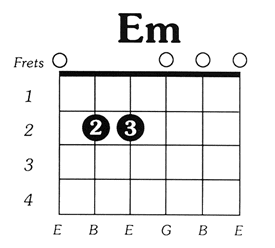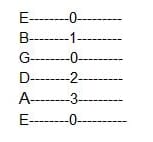Learning to play the guitar is a task that’s undertaken by thousands, if not millions of people each and every year. The guitar, as the second most popular musical instrument in the world (right behind the piano at number one), is the peoples’ choice for a myriad of reasons.
Most commonly, however, people decide they want to play the guitar because of how prominently it’s featured in today’s top music. Many people enjoy pop music because it’s catchy and the lyrics are infectious. The guitar is an easy avenue for those wanting to play their favorite pop songs. It’s also a great instrument to play while singing simultaneously.
What are Guitar Chord Progressions?
Chords are the building blocks to guitar chord progressions. If you think of each chord as a word in a book, you can think of the guitar chord progressions as a sentence in that book.
When you string several sentences together you get a paragraph, and the same is true for guitar chord progressions. If you string chord progressions together, you’ll get a verse to a song. It just keeps building into more complex variations. When you think of chord progressions in this way, it’s easy to understand how they all work together to create the song you’re trying to play.
The Nashville Numbering System
Chord progressions are written with roman numerals called the Nashville numbering system. The system notes the scale degree on which a chord is created. The I is the root, the IV is the fourth note in a scale, and V represents the fifth note in a scale. The progression acts as a template and lets the musician or songwriter create a rhythm.
The I, IV, V, I (one-four-five-one) progression can be heard in much of today’s popular music. Each progression can be played in any key, which allows for endless combinations and sounds. Lowercase roman numerals are utilized to denote minor chords.
Do remember, however, that chord progressions act as a template. Because of this, there are a countless variety of progressions out there. Sure, much of today’s most popular music utilizes the same progressions over and over again, but the key and notes used are often different. This is why songs that share the same guitar chord progression don’t sound like the exact same song. Similar, but not exact. Once you’ve mastered the idea of chord progression, you’ll likely be able to pick out the most common progressions from your favorite songs.
While most of us can’t simply pick up a guitar and start playing without instruction, the process of learning to play a song is fairly straightforward. Once you understand the guitar’s notes, it’s time to learn chords, and then chord progressions.
If you delve into the history of chord progression a bit you’ll find that thousands of songs, from both past and present, use the same chord progressions repeatedly. We need to first understand how chords work before we can move on to chord progressions.
The Chromatic Scale
Before you begin to truly understand chords, you need to first understand the chromatic scale. The chromatic scale is a musical scale that’s broken up into 12 pitches. These semitones are noted on the guitar by the frets.
You’ll notice on your guitar that each fret is separated by a metal strip. These metal strips allow you to change the pitch of a string by altering the length between the string and the bridge. To play a chord, you’ll need to use the scale to put together notes. Three or more notes together create a chord.
You’ll often see chords notated as in the chart above. The six vertical and five horizontal lines represent your guitar’s fretboard.
If you’re confused by the layout of the image above, hold your guitar in front of you so that the strings are facing you and the headstock is pointing up. The image of the chord chart represents this same view of your guitar, with strings running vertically and frets horizontally.
When you look at a guitar chord chart, you’ll notice that there are X’s, unfilled O’s, and filled O’s. The filled O’s will also sometimes contain numbers. The numbers represent which finger you should use to fret the note.
- The unfilled O’s represent open chords.
- The X’s represent strings you won’t play for the chord.
- The filled O’s represent strings you must hold down to play the chord.
[tl-live.class-carousel]
Basic Guitar Notes & Chords
Guitar beginners often get confused with the term “chord” and the term “note.” A chord is a set of notes, usually three, that are played simultaneously. For example, the C major chord contains three notes: C, E, and G.
These three notes strummed together create the C major chord. Try looking at building chords the same way you would use building blocks. The first note is considered the root note and the other notes in the chord are strummed after it.
Here are a few more chord charts for you to study and play:
Open and Barre Chords
There are two types of chords that beginners should be aware of: open chords and barre chords. Open chords only use the first three frets on the guitar and they usually contain one or more open strings. They’re the first chords beginners should learn because they set the stage for an understanding of more complicated cords, such as barre chords.
Barre chords are played with two fingers holding down all or most of the strings of the guitar across multiple frets. The finger can be moved up or down the fret board to create different notes and sounds.
Major chords are the first that beginners should learn. A basic type of major chord is a triad. The triad consists of three notes: the root, a major third, and a perfect fifth. Minor chords are equally as important. You can create a minor triad by playing a root note, a minor third, and a perfect fifth.
How to Read Guitar Chords
Guitar tabs are frequently used to denote the chords that are used in songs. Tabs may seem a bit more complicated, but learning to read chords is no more difficult than reading a chord chart.
The tablature will show the chords to a song from left to right, as if you were reading text. The six horizontal lines represent the strings of the guitar and numbers are attached to each string along the tab. An O represents an open note, which you play without holding down a fret.
If you see numbers like 1,2, or 3, they represent the first, second, or third fret that you hold down. When the numbers are located on top of each other, they’re played simultaneously. Strings that don’t have a number written on top of them are strings that are not played at that moment.
Practicing Guitar Chords
When you’re trying to practice chords, the easiest way to do so is to play some basic songs utilizing the most popular chords in music. There are hundreds of songs that can be played with three chords. You’ll easily find guitar tabs and chord charts for these songs without a doubt.
In many cases, the easiest songs use the C, G, D chords. Once you’ve figured out the very basics of guitar chords, try practicing with these simple songs:
- Happy Birthday Song
- Follow Me by Uncle Kracker
- To Be With You by Mr. Big
- Free Fallin’ by Tom Petty
- Wipe Out by The Surfaris
- The Joker by Steve Miller Band
- The Middle by Jimmy Eat World
- Heart and Soul by Hoagy Carmichael
- Brave by Sara Bareilles
Once you’ve mastered these three-chord songs, you can move on to four-chord songs. Four-chord songs number in the thousands and span every genre of music available.
Many utilize the C, G, D, and Em chords. In fact, much of today’s popular music uses these four chords to construct their music. Some popular four-chord songs include:
- Cruise by Florida Georgia Line
- Be Alright by Justin Bieber
- I Wanna Talk About Me by Toby Keith
- Wrecking Ball by Miley Cyrus
- Say Something by A Great Big World
- She Ain’t You by New Hollow
- Jar of Hearts by Christina Perri
- Vanilla Twilight by Owl City
Common Guitar Chord Progressions
In order to learn guitar chord progressions (instead of simply understanding the concept), you’ll need to practice common progressions. Thankfully, there are several beginner progressions that can help you easily understand how they work. Many songs are created using very basic progressions.
In fact, there are thousands of songs that utilize the most common guitar chord progressions. For beginners, the first three guitar chord progressions are the easiest to learn. Once you’ve mastered them, you can move on to intermediate guitar chord progressions.
50s Progression (I, vi, IV, V or I, vi, ii, V)
It can be heard as early as classical music, most notably in the work of Mozart. It, however, became immensely popular in the 1950s when the Doo-Wop genre used the progression extensively. “Monster Mash” by Boris Picket and “The Book of Love” by The Monotones are notable examples.
Pachelbel’s Progression (I, V, vi, iii)
It’s commonly seen in classical music but it’s also used in more modern songs. For example, Pachelbel’s progression is used in “Canon in D Major,” but it’s also used in Green Day’s “Basketcase.”
Pop-Punk Progression (I, V, vi, IV)
It was popularized in the 1990s but was seen as early as the 1950s in popular music. The progression lends itself to a slightly edgier sound. “Already Gone” by Kelly Clarkson, “Cryin’” by Aerosmith, and “Down Under” by Men at Work all use this progression.
The Blues Progression (I, I, I, I, IV, IV, I, I, V, V, I, I)
It startles the line between a beginner’s progression and an intermediate progression. While the blues progression uses more chord changes than beginner progressions, it’s one of the most commonly used ones. It uses the standard 12-bar blues progression, although songs outside of the genre have used the progression successfully. Tracy Chapman’s “Give Me One Reason” is a good example.
Descending Flamenco Progression (vi, V, IV, III)
It’s an intermediate progression that’s seen in some blues songs and alternative recordings. “California Dreamin’,” for example, uses this guitar chord progression. A variation of this progression (vi, V, VI, V) is also seen more often in modern music.
Stepwise Bass Down (I, V6, vi)
It’s an intermediate progression that uses inverted chords. It’s a relatively new progression that can be heard in “Shut Up and Dance” by Walk the Moon. It can also be heard in songs from the 1960s and 1970s, although it’s rarer than the progressions listed above.
Now that you know all about chord progressions, it will only get easier from here. Make sure you give yourself plenty of time to practice the guitar every day. Happy strumming!
Photo by mark sebastian
Megan L.



